Women Painting WTF They Want
The artwork highlighted in this new curated column on Buzzfeed is focused exclusively on women. Blurbs written by Lorena Kloosterboer.
Sheryl Luxenburg
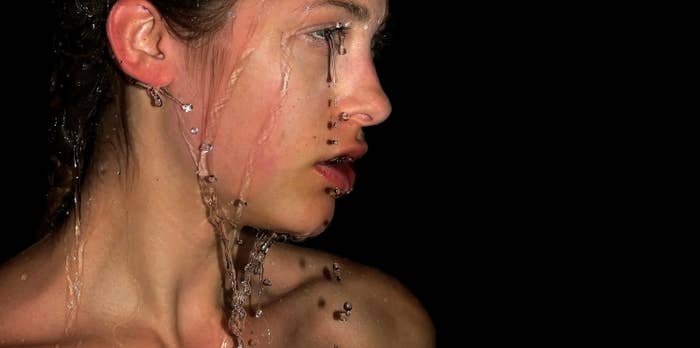
Sheryl Luxenburg is a Canadian hyperrealist artist based in Ottawa who uses watermedia, airbrush, and brush to capture ultra-realistic subject matter, ranging from window reflections and junkyards to figure paintings. Her artwork is so hard to distinguish from reality—especially when viewed online—that many may unwittingly scroll over her work thinking it’s a photograph.
Since childhood Luxenburg demonstrated a predisposition towards painting which was encouraged by her grandfather David, a passionate nonprofessional artist who painted in the cubist style and who taught her how to mix the correct values and colors of pigments from scratch. In her twenties, Luxenburg attained two graduate degrees in clinical psychology. Despite a fulltime job as a licensed psychotherapist, she always continued to paint and attended artist residency programs at The Banff School of Fine Arts in Alberta, Canada. She also had the good fortune to be mentored by the first-generation photorealist Tom Blackwell—renowned for his motorcycle paintings—at Keene State College in New Hampshire, in the US. Blackwell’s methods for capturing flattened depictions of three-dimensional space reinforced Luxenburg’s signature style.
Luxenburg describes the decades she worked as a licensed psychotherapist specializing in trauma and abuse as “highly rewarding.” Her vast knowledge concerning the turbulent human psyche has undoubtedly influenced her artwork. Most of Luxenburg’s work revolves around people or objects that experience some type of distress, such as confusion, dread, conflict, anger, or numbness. Emotions related to feeling overwhelmed, useless, or abandoned also play prominent roles within her compositions. She describes her figures interacting with water as an expression of a fatigued emotional state and her wrecked car series symbolizes the inevitable progression of physical deterioration.
Diagnosed with the autoimmune disorder Systemic Lupus two decades ago and confronted by debilitating symptoms like chronic stiffness and joint pain that drained her energy, she felt forced to retire as a psychotherapist and decided to paint fulltime. After surviving four heart attacks, Luxenburg is determined to be as prolific as time and health allow her.
Anna Wypych

Anna Wypych | Black and White Play (Boson 2) | Oil on canvas | 39 ½ x 27 ½ inches or 100 x 70 cm
Anna Wypych is a figure painter based in Gdynia, Poland, who relies on traditional oil painting methods to achieve a smooth yet painterly realism that also embraces hyperrealistic, surrealist, and expressionist elements. Through her work, Wypych examines life and the universal human condition, basing compositions on her thoughts, emotions, and experiences as well as concepts such as beauty, honesty, inner strength, and justice
While she doesn’t want to influence the viewer’s personal perception of her work, she feels a need to translate her personal thoughts into words in order to clarify the deeper meaning behind each piece. Even when some belong within a series, each painting is a separate project with a specific subject which she often accompanies with texts and sometimes poetry. She states, “I take inspiration from what I see around me, but my personal thoughts are always the starting point.”
Currently she’s working on a series about freedom, simply called Boson. The word pertains to the Higgs Boson, a particle in the Standard Model of physics that is thought to be responsible for all physical forces. From an artist’s point of view, Wypych relates the Boson particle to the potential within every human being and the interactions between them—the creative energy of all the possibilities within and around us. She emphasizes the interconnection and interrelatedness between ourselves and the world around us while trying to let go of individualistic notions of herself, seeking to feel connected to both animate and inanimate matter.
Regarding the Boson series, she says, “Molecules each have their own weight, and are what they are, the point is the variety of molecules. For me Boson is something what makes people different from each other, makes people who they are—that is freedom. Boson is freedom.” This series deals with her search to understand what freedom means, how it shapes us, and the ways in which freedom affects us.
Wypych’s powerful painting, entitled Black and White Play, represents making difficult decisions in life—it is about having to choose between two bad options. The model, smearing herself with paint, looks defiantly at the viewer, rebelling against the sociocultural notion of the way many of us—especially women—have been trained to be submissive and dependent. As in: good girls are clean and pure, their bodies are under control, and usually not their own. In this context, getting dirty is an expression of liberation.
Wypych is a thoughtful person, an empathic thinker who takes the state of the world seriously—and as happens to most empaths, frequently gets chastised for being too serious and too sensitive when dealing with problems not exclusively her own. In an attempt to shake off the heavy burden of worrying about humanity, Wypych hid humorous elements within this painting; there’s a monster on the skin, a cat’s eyes and ears, a cartoon bear, a snail without a shell, a praying mantis who also looks like the letter F, a small heart, a weird pelican, and big cow with lean legs. See whether you can spot them.
Jenny Morgan
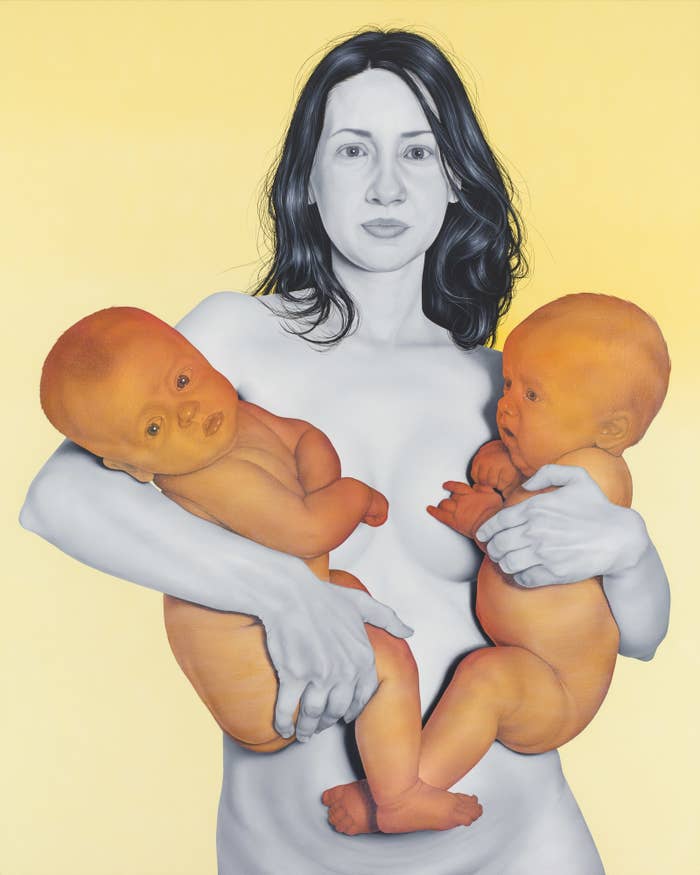
Jenny Morgan paints the human figure breaking away from classical approaches by using striking color schemes and inventive surface treatments that give a fresh interpretation to traditional portraiture. Her method involves the annihilation of impeccably painted portraits, sanding them down to strip away layers in order to symbolically reveal physical and spiritual wounds of the flesh. In her work, Morgan seeks to examine the complexities of human relationships and to expose the psychological multiplicities of the ego. Morgan’s innovative color-use, interesting compositions, and partially abstracted content superbly come together in a highly-sophisticated body of work.
Morgan’s painting, Lifted, depicts her close friend Caitlin holding twin sons. This piece focuses on motherhood, the emotions connecting family and friendships, and the decision modern women face regarding procreation. In this piece, the transformative power of motherhood is seen in the purposeful, serene look of the woman—depicted in grisaille, symbolizing the stability and strength of a marble sculpture—while protectively and firmly holding the children who are full of light, life, and color. Morgan’s emotional involvement shines through in the sensitive and alluring expression of the subject matter.
Caroline Westerhout
Caroline Westerhout is a Dutch artist living and working in the Netherlands. She paints the human figure in a highly recognizable, singular style, with an emphasis on faces, hands, and the female anatomy.
I first encountered Westerhout’s paintings several years ago, which appeared inspired by one of my favorite artists, Gustav Klimt. Borrowing and building upon Klimt’s signature graphic lines and shapes, and combining them with smooth realism, it’s obvious Westerhout did not mimic Klimt—instead she built upon his legacy in her own distinct style. This, to me, is the optimum result of cross-pollination between artists.
Rebecca Leveille
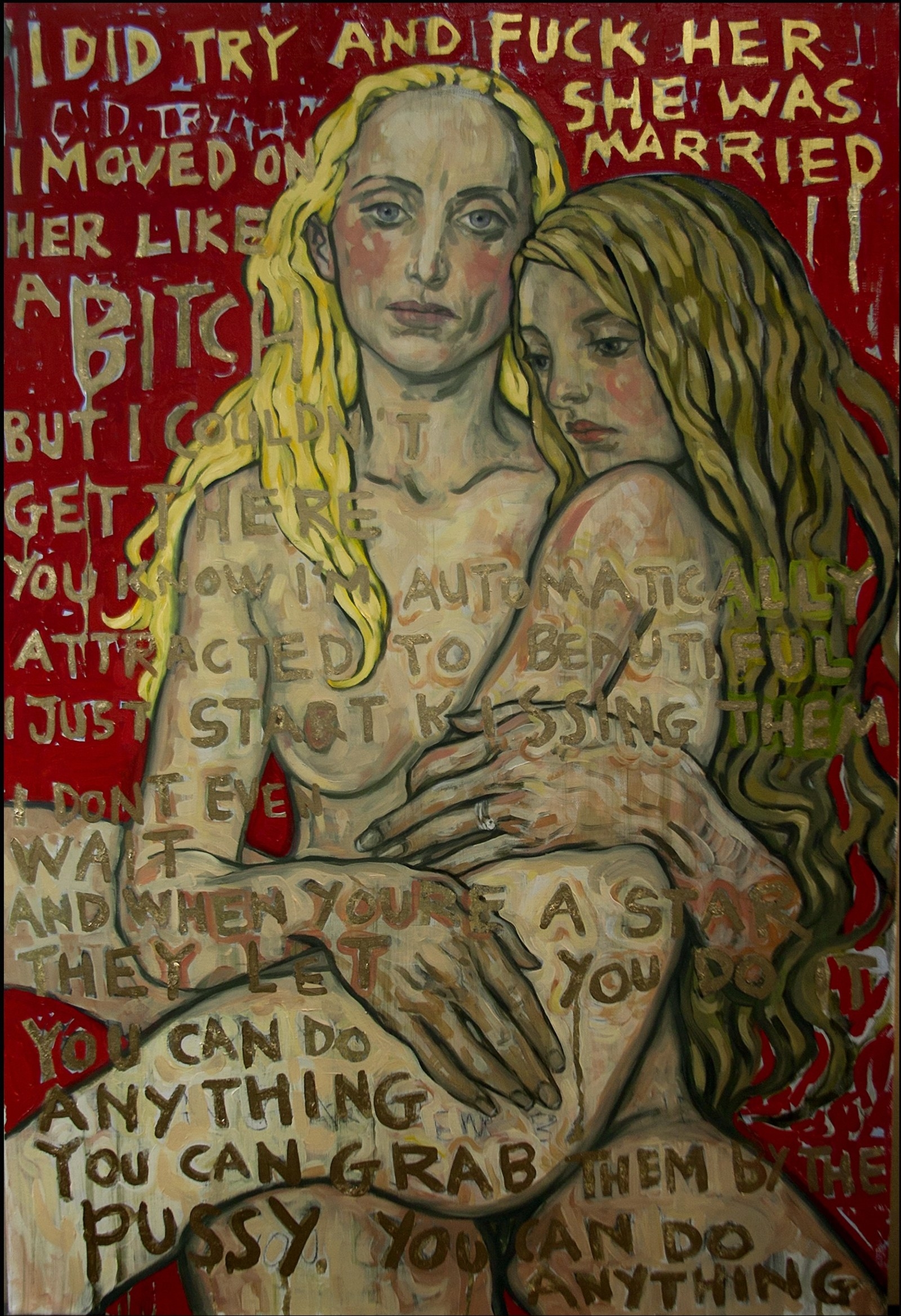
R. Leveille’s modernist paintings hover between Pop Art, Expressionism, and Art Nouveau, using expressive brushstrokes and a lush, colorful palette to create strong pictorial content that conveys a powerful message. Leveille inducts the narrative of each piece by strongly delineated figures, adding powerful design elements and text, so that the visual content doesn’t crumble under the weight of her subject matter. She succeeds at directing the viewer’s focus of attention towards both visual and analytical content.
Leveille’s paintings invite the viewer to look beyond the archetypal female figures and engage with the story that plays out in quite palpable terms, supported by witty symbolism and well-chosen, relevant words or sentences. Touching upon personal themes, such as sexual identity, sensuality, feminism, and today’s sociocultural and political currents, Leveille firmly uses her paintings as megaphones, sharing her point of view and asking for awareness.
Leveille’s painting You Can Do Anything speaks of a deep-seated anger and frustration many women as well as men share. Numerous amongst us, including Leveille, have survived sexual assault and many more of us have suffered under sexual harassment. The entitlement-fueled behavior of sexual predators—using both verbal as well as physical force—inflicts deep wounds in those they target and forever scars them.
Most of us do not tolerate aggressive, predacious behavior—whether by word or deed—rejecting and distrusting those who conduct themselves in this way. Yet sadly many are still willing to overlook this type of behavior and find reasons to tolerate, condone, and even justify the infamous words depicted on the canvas—disgustingly depraved statements that allegorically defile the portrait of the artist and her young daughter. Leveille is not alone in being horrified that so many seem to condone the pervasive rape culture that is sustained and even encouraged by those in power. As a woman and a mother, Leveille feels compelled to express her anger, despair, and utter disgust, resulting in You Can Do Anything, a solid, beautiful, and authentic interpretation of her present state of mind.
Sharon Moody
Sharon Moody is an American artist and art professor based in Virginia, USA, who’s best known for her superb series of paintings depicting classic comic books. Influenced by the Pop Art and Photorealist movements, Moody specializes in creating trompe l’oeil paintings that capture ordinary contemporary items and presents them as sharply focused formal compositions on a sedate, neutral background. Trompe l’oeil—French for “fool the eye”—is a specialized corner of the still life genre portraying an assortment of fairly flat, meticulously rendered life-sized objects, with an emphasis on recognizable textures, such as torn paper or wood grain, that are depicted in such a way that they look naturally placed within the framework of the painting. In order to avoid spoiling the illusion, Moody always unobtrusively hides her signatures within her compositions.
Claudia Kaak
Claudia Kaak is a German self-taught artist who paints the human figure. She puts emphasis on facial expressions and body language while leaving backgrounds purposely nondescript in order to avoid distracting the viewer, allowing more focus on the subliminal content. Inspired by Rembrandt’s chiaroscuros and Lucian Freud’s brush strokes, Kaak paints in loose flowing gestures, basing her paintings on photographs and movie stills.
Coming from a working-class broken home that looked down on “frivolous” creative and intellectual pursuits, Kaak found her passion for painting at age twenty-one. Her love for art and art history have allowed her to discover a vital form of self-expression that she converts into a proactive, creative method to work through her childhood experiences.
Instead of giving them titles, Kaak assigns each painting with a number to form part of a numbered series in order to avoid impressing the viewer with a preconceived idea—she prefers viewers to engage with the deeper meanings of her artwork through their own visceral reactions. Every series has an autobiographical and often society-critical narrative—some series are open ended and ongoing, which means new paintings will be added, while other series are closed. Thematically all her work is interconnected, yet every series and each painting can also be appreciated by itself.
Another reason Kaak prefers to leave work untitled and nameless is that its essence and subject matter are hard for her to put into words because they deal with existential feelings she hasn’t fully worked out yet. These paintings capture psychologically emotive fragments in time, describing a past of internal turmoil and profound suffering, and relate to previously lived violence and trauma not explicitly shown in her work.
Amanda Greive
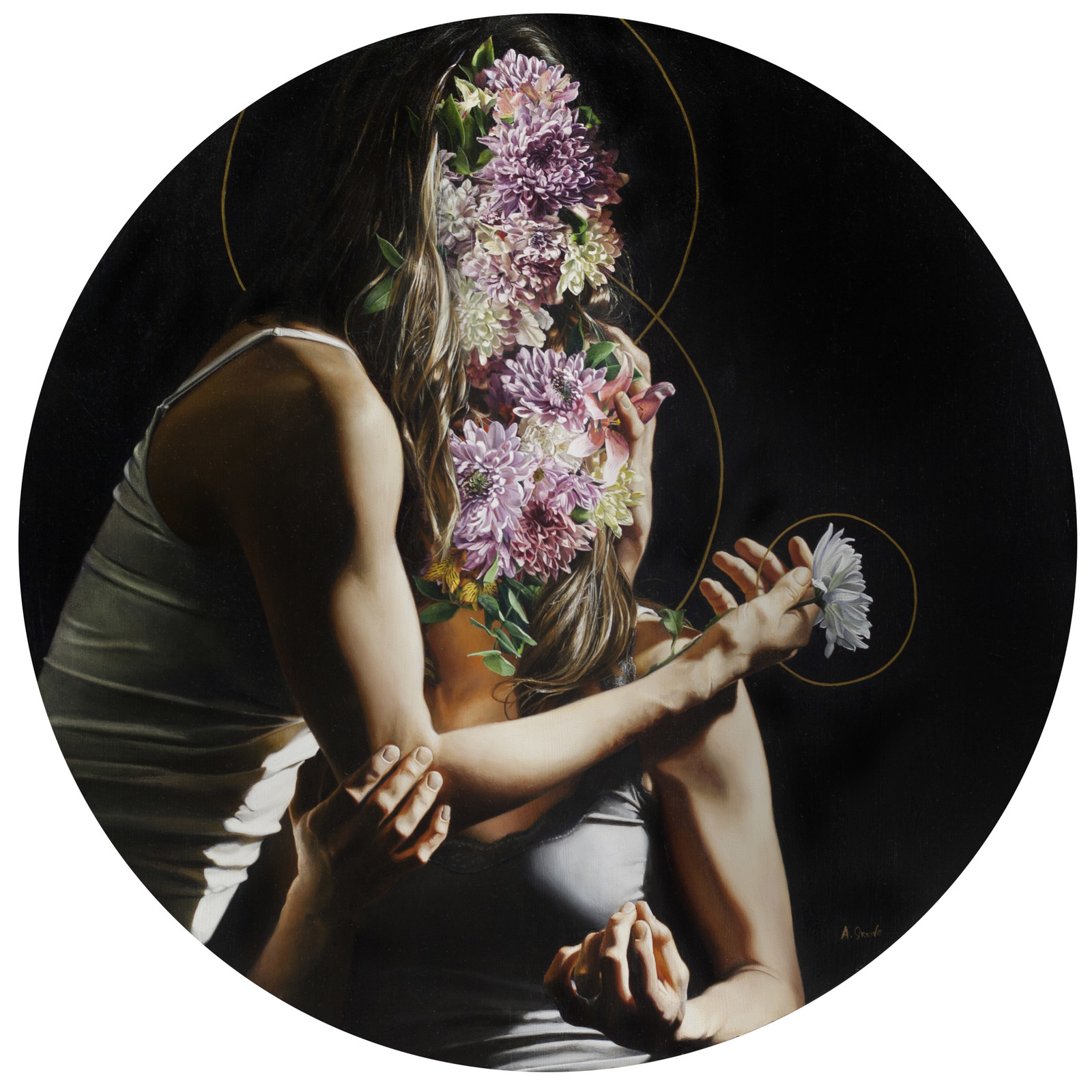
Influenced by both classical and contemporary iconography, Amanda Greive’s dramatic hyperrealist paintings include beautifully bizarre and artistically innovative compositions of women posing with flowers. Greive eloquently captures emotional authenticity while faithfully expressing fundamental truths. In her work, Greive examines the myriad of conflicting emotions embedded within the human condition, especially in regards to the isolation and anxiety born out of gender-based stereotypes. These masterful paintings aim to shine a light on the pressures women face to conform to widely imposed sociocultural ideals. The flowers adroitly symbolize society’s paradoxical views on women, superbly capturing the dichotomy of being fragile, decorative, and sexual, as well as strong, tenacious, and adaptable.
Patrice Robinson
Patrice Robinson makes the human figure the focal point of her paintings, often juxtaposing vibrant colors against darker ones to emphasize bold, philosophical narratives. Robinson’s figures habitually appear lost in thought, withdrawn from the viewer, or sometimes appear in tight close-up, accentuating the idea we all live different lives despite our innate similarities and shared experiences. Building upon her own life experiences, Robinson skillfully incorporates universal emotions—such as loneliness, fear, and heartbreak, as well as hope, growth, and passion—into her subject matter, highlighting how the past influences the present.
Aiming to bridge social anonymity and emotional distance, Robinson’s portraits illustrate the complexities of life generously sharing her psychological, spiritual, and autobiographical narrative with the viewer. Illuminating contrasting concepts—such as the conscious versus the subliminal, multiple personalities versus one-dimensionality, self-determination versus mind control—the atmosphere surrounding Robinson’s figures provoke deep emotions and invite us to connect with her narrative on a deeper level.
Shana Levenson
Shana Levenson paints contemporary portraits in a classical approach, in a quest to go beyond realism to capture the personal truth and genuine essence of the subject. She seeks a deeper connection with the people she paints, sharing their personal stories and experiences with sensitivity and respect.
Levenson’s portrait, entitled Paul, is part of her series Beyond the Illness in which she examines personal stories of survival as well as loss surrounding life-threatening ailments. This serene and elegant portrait depicts a stately man with a calm, compassionate gaze and delicate features comes alive in vivid color. Knowing that this man is a heterosexual long-term HIV/AIDS survivor who lives with a disease that—against all odds—has not defeated him in the past three decades, places this portrait in a new light. Levenson has brilliantly captured Paul, who has come to terms with the uncertainties and suffering in life, bravely and unwaveringly staring back at us with kind-heartedness and profound wisdom.
Katie Miller
Katie Miller’s vibrant, ultra-sharp realist paintings of children immediately attract the eye due to their exceptional compositions, bright colors, and exquisite artistry. To Miller, hyperrealism isn’t only an artistic genre but also a philosophical concept concerning the blurring of the real and artificial, the true and false, particularly in today’s sociopolitical and media landscape.
In her ongoing series, entitled HYPERREAL, Miller explores the fusion of real and fake, of natural and artificial, and how these opposing concepts challenge us to discriminate original from copy. In this series of paintings Miller uses settings considered to be “recreational simulacra”—such as zoos, casinos, theme parks, and living history exhibits—to create environments that function as backdrops for the exploratory, open-ended narrative she conducts through her art.
Miller’s delightfully dynamic piece, entitled Twins by the Trees, show two young girls in what, at first glance, seems a natural environment. However, upon closer inspection we notice that the children are standing in front of a fence holding a printed banner which, in turn, hides real trees in the background—an artificial setting within a natural one. Self-conscious postures and expressions convey that the toddlers are highly aware of being on display.
Miller’s painting Girl behind a Tinsel Veil—part of her Enduring series—explores social pressures, such as gender roles, affecting children. The broad sociocultural symbolism of the veil serves as basis for the narrative; the girl’s face is hidden by a cheap, mass-produced tinsel streamer symbolizing the expectations and pressures of today’s beauty standards on increasingly younger girls.
Daniela Kovacic
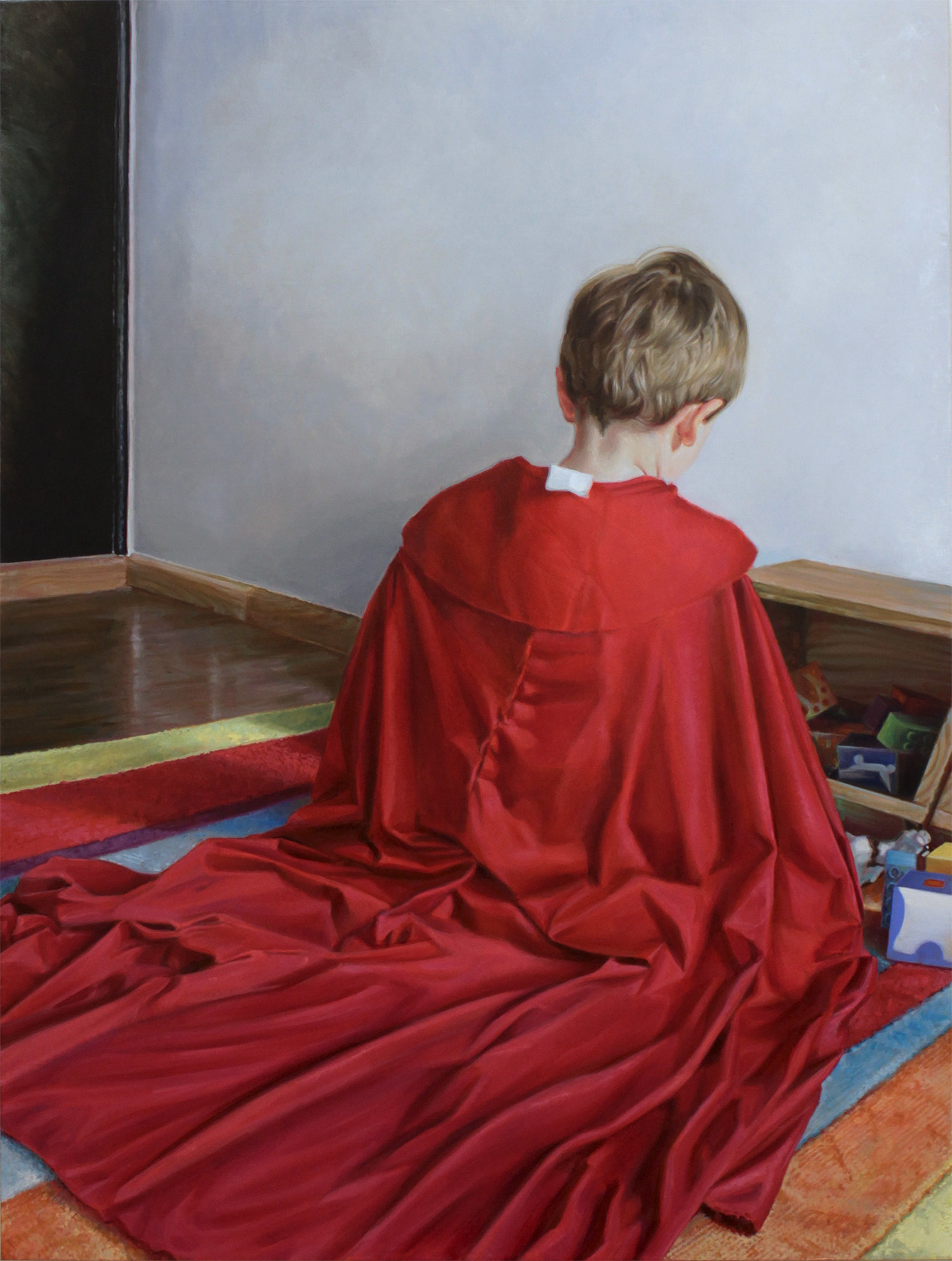
Chilean figure painter Daniela Kovačić examines sociocultural topics, such as self-identity and collective identity, through her paintings of women and children. Her striking portraits focus on the gaze and body language of her subjects casually placed in commonplace settings, revealing her keen interest in psychology and human nature. Kovačić’s dynamic compositions—handled in a realistic, painterly style—are built up in strong, loose brushstrokes with a keen eye for lighting and a subtle color palette, emphasizing the atmosphere of the gripping narrative.
Victoria Selbach
Victoria Selbach paints the female figure in celebration of the heroic spirit in all women. Through her art, she examines the complexities that ultimately contribute to who we are and how we behave. Selbach’s series, entitled Generational Tapestry, examines the myriad ways in which previous generations of women influence who we are today. She celebrates the mothers and grandmothers on whose shoulders we stand today, whose actions and teachings continue to influence new and future generations of daughters, granddaughters, and great-granddaughters. Selbach marvels at the continuum of the generational matrilineal legacy that shapes our identities and binds us together.
In her Generational Tapestry series, Selbach breaks away from traditional methods and paints young female figures on top of collaged backgrounds that include vintage keepsakes emblematically placing the figure on top of the historic legacy that shapes and supports her. The cherished keepsakes lovingly made by Selbach’s own and her friends’ grandmothers’ hands offer but a fractured glimpse of the maker’s identity, yet define the world in which she lived, forming a base for a partial memoir on which Selbach builds new narratives.
In her piece, entitled In Our Mother’s Grace, Selbach seeks to examine the impact of religious doctrine and devout faith passed on through the generations. The Catholic prints in the background are family heirlooms—holy portraits that inertly stare at fractured and often lost connections to subsequent generations, while their cultural indoctrination continue to shape identities and affect actions. Delicate handmade Eastern European table linen and elegant embroidered hand towels find new life as backdrops for a kneeling female figure, who turns—perhaps in embarrassment—to hide her face, her nudity, in a symbolic gesture that shows the involuntary impact of the inheritance of previous generations.
Our Mother’s Bounty shows a carefree nude reclining on embroidered linens that reference the unused table linens and guest towels so often kept pristine for visitors or special occasions. The backdrop of vintage cookbook images represents the universal importance women place on providing abundant nourishment for their families. Besides offering recipes, old cookbooks also advised and instructed readers on household gender roles, appropriate entertaining, and other domestic duties. Educational images within the collage highlight a strict hierarchy of women baking, tossing salads, and setting the table while men fire the grill and carve the meat as eager well-behaved children keenly watch and learn. While feeding the family is still a priority for most women, the contrast between the liberated female figure and the other images referencing the restrictions placed on previous generations of women is amusing, yet serves as a valuable reminder of how far we’ve come.
Shelli Langdale
Shelli Langdale is an American artist and a wide-area network engineer for NASA based in Tennessee, USA, whose abstracted representational paintings are centered around ambiguous personal narratives. Langdale’s paintings—ranging from portraits, landscapes, still lifes, and animals—are strengthened by bold, decisive mark-making that suggests shapes and open spaces instead of delineating them precisely.
Erica Elan Ciganek
Erica Elan Ciganek portraits depict close-ups of cropped faces, focused on truly seeing the individual beyond the veils of societal biases and preconceptions—beyond the identification of skin color or socioeconomic status that exist as structures to suppress, devaluate, and dehumanize others. Rivulets of water serve a dual symbolism, in that the water represents the filter that skews our views that divide us, while also uniting us in our common human experience. Ciganek’s work seeks to challenge society’s rampant dehumanization—in particular regarding black people—by inviting the viewer to see beyond power structures and respond with a deeper, more visceral understanding that celebrates life and embraces the pleasures of discovery.
Heidi Elbers
Heidi Elbers paints the human figure in loose, painterly brush strokes, always leaving the background white and vaguely nebulous in order to avoid distraction and maintain the focus on her subject. Her fascination with extravagant costumes started early in life. Embellishments related to Mardi Gras and the cultural history of the Bayou region—such as furs, sequins, and feathers—are used to accentuate physical beauty. Her latest body of work examines the balance between beauty and masculinity. Typical male activities—such as that of hunter, trapper, or soldier—form part of the narrative, often playfully juxtaposed against archetypal feminine traits.
Erin Anderson
Erin Anderson paints the human figure using oil on copper sheet. In her body of work, she explores the dynamics of interpersonal relationships as well as the fundamental connections between humans and the environment. The interplay between paint and metal substrate allow her to portray different levels of reality, revealing dynamic and changing layers that can either be perceived directly or sensed instinctively. Her figures are anchored in a classical representational approach, exquisitely rendered in a detailed yet subtle manner.
Michelle Doll
Michelle Doll’s paintings center on the human figure in touchingly intimate poses that speak of those silent, fleeting moments of physical interconnection between people. She portrays the significance of emotional energy—either present or desired—which she captures in a delicate realism infused with easy sensuality. Doll examines the profound significance of the power of love, our desire for touch, and the fragility of unity. Doll’s subjects are real people portrayed from an introspective viewpoint. To avoid influencing the viewer with a title, Doll catalogues her work with the initials of her models so we may experience the artwork from a purely personal perspective.
Sylvia Maier
Sylvia Maier paints American narratives in broad, supple brush strokes, inspired by Rembrandt’s raw mystery and the passion of the Renaissance. Influenced by her biracial heritage she examines current cultural differences within familiar social settings in public places. Maier approaches each piece by sketching an impromptu scene that catches her eye, after which she recreates the tableau with models in order to gain deeper artistic insight and work out the subject matter. She aims to capture a multicultural figurative world, where art, music, ceremony, and tolerance reign.
Maier’s piece, entitled Mothers Milk, is a slice-of-life glimpse into a Brooklyn café, vaguely reminiscent of Norman Rockwell’s The Runaway. While the women are absorbed in passionate discussion, the child is the only one noticing the spilling milk, symbolizing the differences in perception and perspective that each of us have at any given moment in time. The Maizena references Maier’s Afro-Latin food culture; the touch of bright yellow counterbalancing the more muted overall palette.
Nadine Robbins
Nadine Robbins uses an academic approach grounded in atelier tradition to achieve artwork that honors the historic legacy of portraiture depicting today’s world. She paints ordinary people from all walks of life with distinct emotional clarity. Robbins captures inner beauty in a touching and oft amusing manner that suggests intimacy, tenderness, and an understanding of the human experience, emphasizing the duality between bravado and vulnerability.
Omalix
Omalix paints the female figure with an emphasis on a personal narrative through which she explores her emotions and experiences—those which she cannot express in any other way. Her classical, highly skilled approach to textures and details reflects her love for realism. Despite high detail, she aims for visible brush strokes that retain evidence of the presence of her hand. Omalix strongly believes that the act of painting always translates into a form of self-portraiture, whether she paints herself or a model.
Lee Price
Lee Price paints the solitary, isolated female figure from an elevated downward-looking viewpoint that suggests self-reflection—looking at oneself from a psychological perspective. In her work, Price examines our relationship with food and how compulsive behavior is often expressed in secrecy and solitude in unusual settings, such as bathtubs and bedrooms. While her exquisitely detailed work conveys an apparent atmosphere of pleasure, the underlying implications emphatically touch upon our fears—and sometimes our reality—of feeling out-of-control panic, paralyzing guilt and shame, and energy wasted on self-destructive behavior. The strength and perceptiveness of Price’s work is reinforced by a vivid, contemporary color palette and gracefully detailed realism.
Carmen Chami
Mexican artist Carmen Chami’s painting methods are highly influenced by her background in professional art restoration in which she specializes in the great 17th Century Masters of the New Spanish Baroque. Inspired by these historic painting techniques which produce sumptuously rich colors and light, she researched and studied the best Mexican baroque artists—such as Cristóbal de Villalpando and Juan Correa—which led her to discover their precise sequence of color application using just eight pigments. Today, Chami uses this precious knowledge to create her own paintings, in which color plays a central role to achieve powerful, elegant, and highly dramatic expression. Chami’s compositions are based on narratives inspired by people. There’s intimacy in her creative process that guides her models to interact with their surroundings, resulting in hyperbolic, flamboyant poses.
Judith Peck
Judith Peck is an American artist based in Virginia, USA, who has made it her life’s work to paint about history and healing, using a variety of mediums and experimental techniques to achieve a diverse range of visual and tactile results that validate a strong narrative. Peck often paints on shards of broken plaster, emblematic for a world falling apart, yet symbolically held together by the figure depicted within. The penetrating gaze of Peck’s portrait subjects seeks to move the viewer out of complacency towards understanding the meaning and preciousness of life in order to start healing a broken world. To Peck, healing is a universal human undertaking which she aims to capture in her profoundly compassionate paintings.
Natalie Holland
Natalie Holland, born in St. Petersburg, Russia, is a classically trained artist. After graduating from the Russian Academy of Arts she relocated to Norway and later moved to London, fascinated by its multicultural diversity, cosmopolitanism, and dynamic art scene.
Natalie Holland is best known for her traditional figure paintings, often portraying everyday people she discovers in her neighborhood. Her captivating symbolic figurative work focuses on contemporary societal narratives such as feminism, human rights, religion, and today’s sociopolitical challenges.
Pam Hawkes
Pam Hawkes is a British artist based in Warwickshire, UK, whose sedately seductive figure paintings are based on the traditions of Renaissance portraiture. In her work, Hawkes mythologizes her life experiences into beautiful images, inviting viewers to discover pictorial analogies that remind them of their own narratives, idealized memories, and near-forgotten tales. Inspired by medieval manuscripts, Hawkes paints directly onto metal leaf without a preliminary sketch, finding the history of the painting—i.e., the marks and traces left from the trajectory—the most fascinating. Hawkes’ work is often steeped in dark light and melancholia through which she seeks to acknowledge and honor life’s losses.
Tenley DuBois
Tenley DuBois is an American artist based in Washington, USA, whose loosely-painted representational artwork covers a wide variety of subject matter based on a personal narrative that aims to evoke an emotional response from the viewer. Writing lays the groundwork for her paintings, which then leads to sketching and photographing her subject matter. DuBois doesn’t rely on exact rendering; instead she prefers to gesturally respond to a thought or emotion to guide her creative endeavor. DuBois usually starts with a thin layer of paint and wipes out the basic structural features, subsequently building up layers and pushing paint around using a painting knife and brushes to shape and transform the surface.
Lorena Pugh
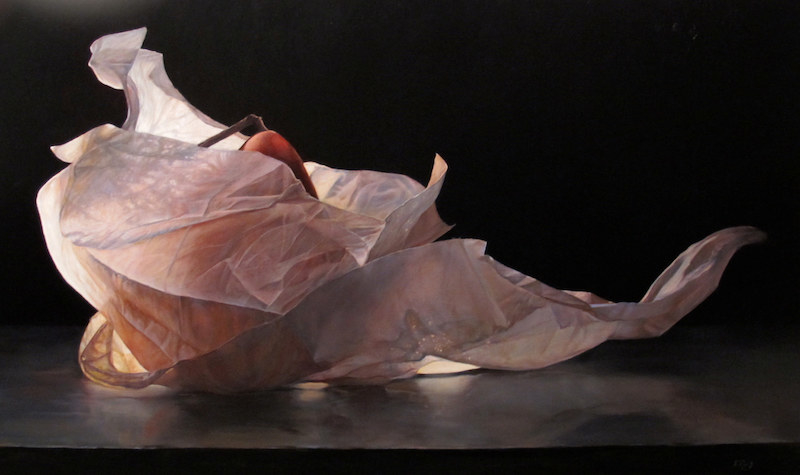
Lorena Pugh is an American contemporary realist artist and illustrator based in Rhode Island, USA, whose paintings examine the visual chemistry happening between translucency, organic form, and light. In her still lifes Pugh examines the abstracted shapes created by diffuse light hitting pears enfolded in crumpled tissue paper—which Pugh describes as “her muse”—elegantly juxtaposing mysterious, warped silhouettes against a dark background. The pears’ voluptuous shapes reflect the feminine form and seek to probe our universal perceptions of the female figure by celebrating natural beauty. Pugh builds up her paintings by applying multiple layers of glazing that allow her to create subtle variations in the paint’s opacity and translucency to achieve an exquisite illusion of light. Through her artwork, Pugh endeavors to tap into the unknown and unspoken aspects of herself to gain a deeper understanding of life.
Judy Takács
Judy Takács is a figure painter who captures her subject matter with painterly brushstrokes based upon the tenets of realism, skillfully honoring her chosen medium, oils. Takács favorite color, red, often functions as a foundation for her supports on which she masterfully creates skin tones that bring her subjects to life. She seeks to capture her subject matter with empathy and a bit of irony in order to express reality, tell a story, and convey shared human struggles. Usually, Takács’ models are strong, mature women with expressive facial features to help impart her striking visual ideas.
Maria Mijares
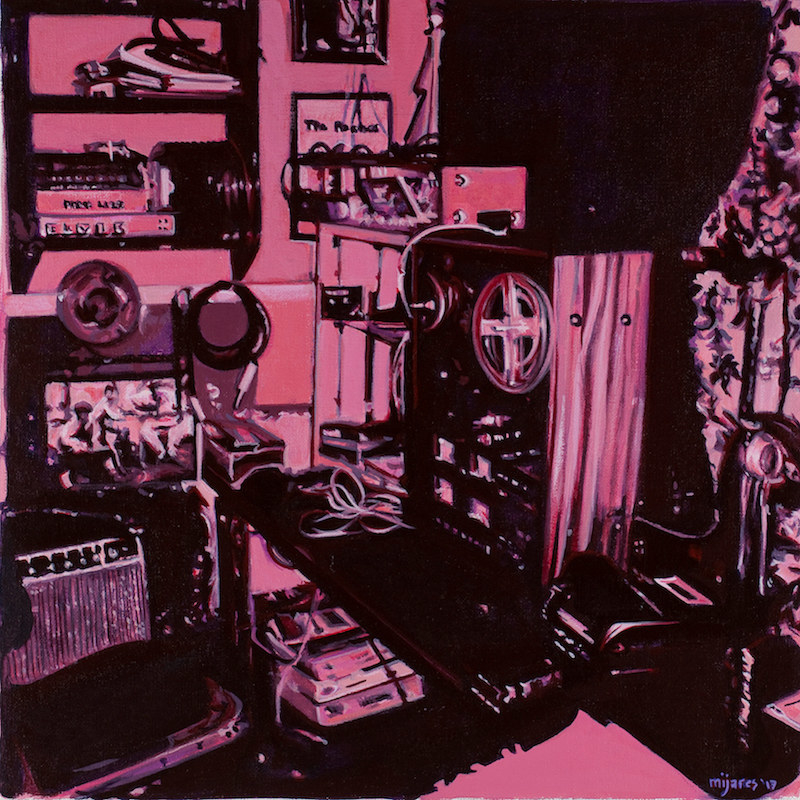
Maria Mijares is an American artist of Spanish descent based in New Jersey, USA, whose contemporary realist cityscapes and interior paintings always start out as a collection of abstract shapes that progress into representation as a compilation of poetic vignettes. Mijares dignifies each brushstroke with importance, thoughtfully evaluating the qualities of each shape, pushing truth to the edge. In her paintings, she creates an imaginary realm she would like to live in—a colorful, balanced, and harmonious world. In an effort to understand her trajectory Mijares relies on writing in order to shape and add structure to her visual ideas. Her style is described as “psychedelic precision” through which she aims to find beauty within the ugly and mundane, building upon philosophical insight.
Yana Beylinson
Yana Beylinson is a Russian artist, graphic designer, and illustrator based in New Jersey, USA, whose colorful paintings of floral and botanical forms—often painted on circular supports—have a distinctly contemporary appeal hovering gracefully between realism and abstraction. Beylinson’s artwork is primarily based on emotions and memories of places and times which she skillfully translates into bold colors and shapes, capturing the sublime elegance of flora’s precious gifts. Beylinson implements loose, thick brushstrokes that look accidental but are, in fact, quite premeditated and intentional in nature. She carefully avoids overworking the paint to keep it looking fresh and bright.
Anzhelika A. Doliba
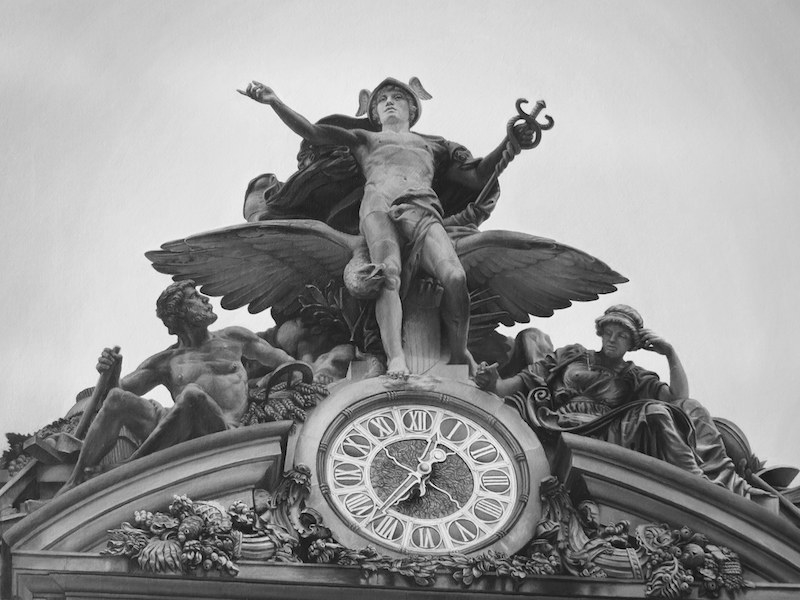
Anzhelika A. Doliba is a Ukrainian artist living and working in New Jersey, USA, who employs a variety of media to create a range of subject matter using a classical realist approach. In addition to accurately portraying the intricacies of structural details, Doliba is interested in capturing mood and atmosphere as a means to interpret the here and now. Starting out with a black surface, she uses black and white to achieve a full scale of values to paint detailed grisaille. The skillful application of values results in an impactful, highly sculptural three-dimensionality in which methodically applied brushstrokes retain an intimate painterly appearance.
Doliba’s delightful architectural painting, entitled Grand Central Terminal, NYC, draws me because of its meticulously detailed quality. I share Doliba’s fascination with historic buildings that show influences of distinct historical and cultural periods. New York’s Grand Central Station boasts monumental spaces and meticulously crafted detail, especially on its façade. Doliba’s painting zooms in on Glory of Commerce, a sculptural group by Jules-Félix Coutan featuring statues of Hercules, Minerva and Mercury, a lovely example of magnificent design honoring an era when architects and artists still successfully worked together to create functional, beautiful buildings.
Josie McCoy
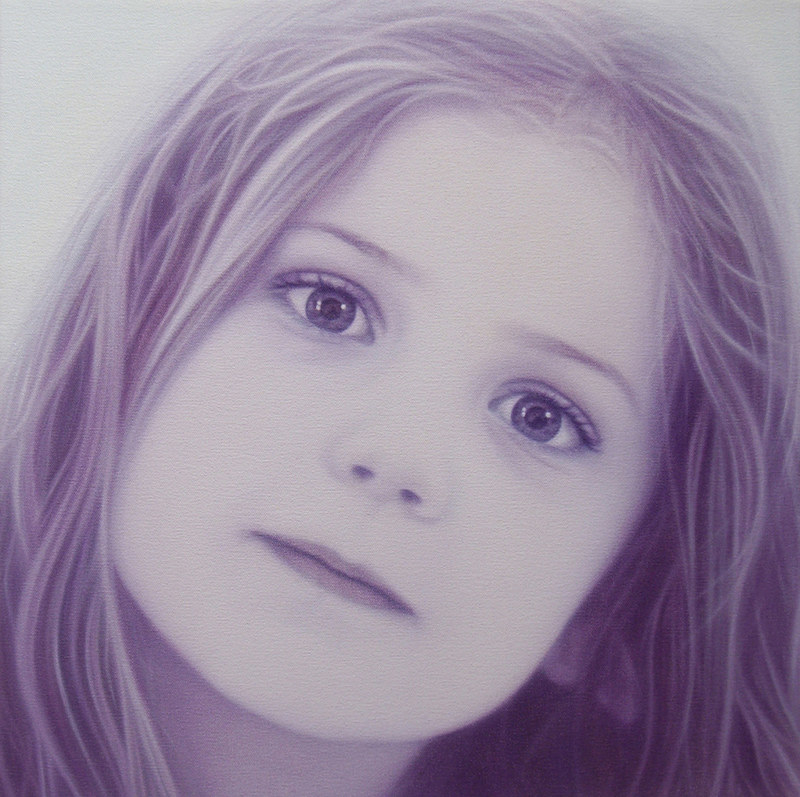
Josie McCoy is a British artist currently based in Valencia, Spain, whose soft-focus portraits of film and television characters attempt to blur the line between reality and fiction. Within her paintings, McCoy examines an artificial version of reality offered through both television and art, inviting the viewer to connect with fictional yet familiar subject matter. Working from photographs taken from the television enables McCoy to paint an isolated moment which the actor has not specifically performed for, capturing close-ups of dramatic moments that show strong emotion. By applying many layers of diluted paint—using oils like transparent watercolors—she skillfully renders the luminosity of the television screen on canvas, painting the bare minimum of features needed for figures to be recognizable and their expression understood.
Marie Cameron
Marie Cameron is an American-Canadian artist, designer, and illustrator based in California, USA, who paints a wide variety of colorful subject matter in which the importance of symbolism and narrative form the base for the creative content. Cameron builds up her paintings with luxurious loose brush strokes and rich transparent glazes, often allowing abstract patterns to play a prominent role in support of her signature genre of contemporary realism. Painting her still lifes from studio setups, she skillfully brings her main subject into sharp focus and lavishes individual minutiae with generous attention to detail.
Laura Shechter
Laura Shechter is an American artist, art lecturer, and occasional art teacher based in Brooklyn, USA, whose contemporary realist still lifes and cityscapes are rooted in the concept of perceptualism—in other words, her paintings are not mere reproductions of imagery but instead are based on optical truth found upon consideration of a basic sensory understanding. Interestingly, Shechter’s still lifes borrow spatial relationships from her cityscapes and vice versa. Inspired by northern Renaissance art, Indian miniatures, and the Feminist art movement, Shechter seeks to capture a moment of light with all of its visual contradictions, bestowing a certain linear formality to her objects while aiming to achieve a beautiful and sensual surface.
Laurence de Valmy
Laurence de Valmy is a French artist based in New Jersey, USA, who paints a variety of unpretentious subject matter that she chooses based on simplicity of shapes and bright color schemes, and are linked to moments and places that hold special meaning in her life. De Valmy’s seemingly casual brushstrokes betray a skilled eye for how she interprets and consolidates complex compositions into vivid, realistic impressions, finding a perfect balance between sharp and lost edges. Her aim is to draw in the viewer and elicit a positive emotional response—de Valmy’s artwork offers the viewer a moment of simple happiness.
Camille Engel
Camille Engel is an American artist based in Tennessee, USA, who paints a wide variety of subject matter in vivid colors and detailed splendor firmly based on the principles of classical realism, yet presenting her compositions in a fresh, contemporary manner. Engel seeks to capture the richness of life, inviting viewers to momentarily step into her world and experience the transcendent beauty of simple things. Inspired by the traditional methods used by Golden Age Dutch artists, self-taught Engel builds up her paintings in multiple layers to modulate colors, adjust values, and painstakingly create a myriad of eye-catching details.
Become a Community Contributor.

